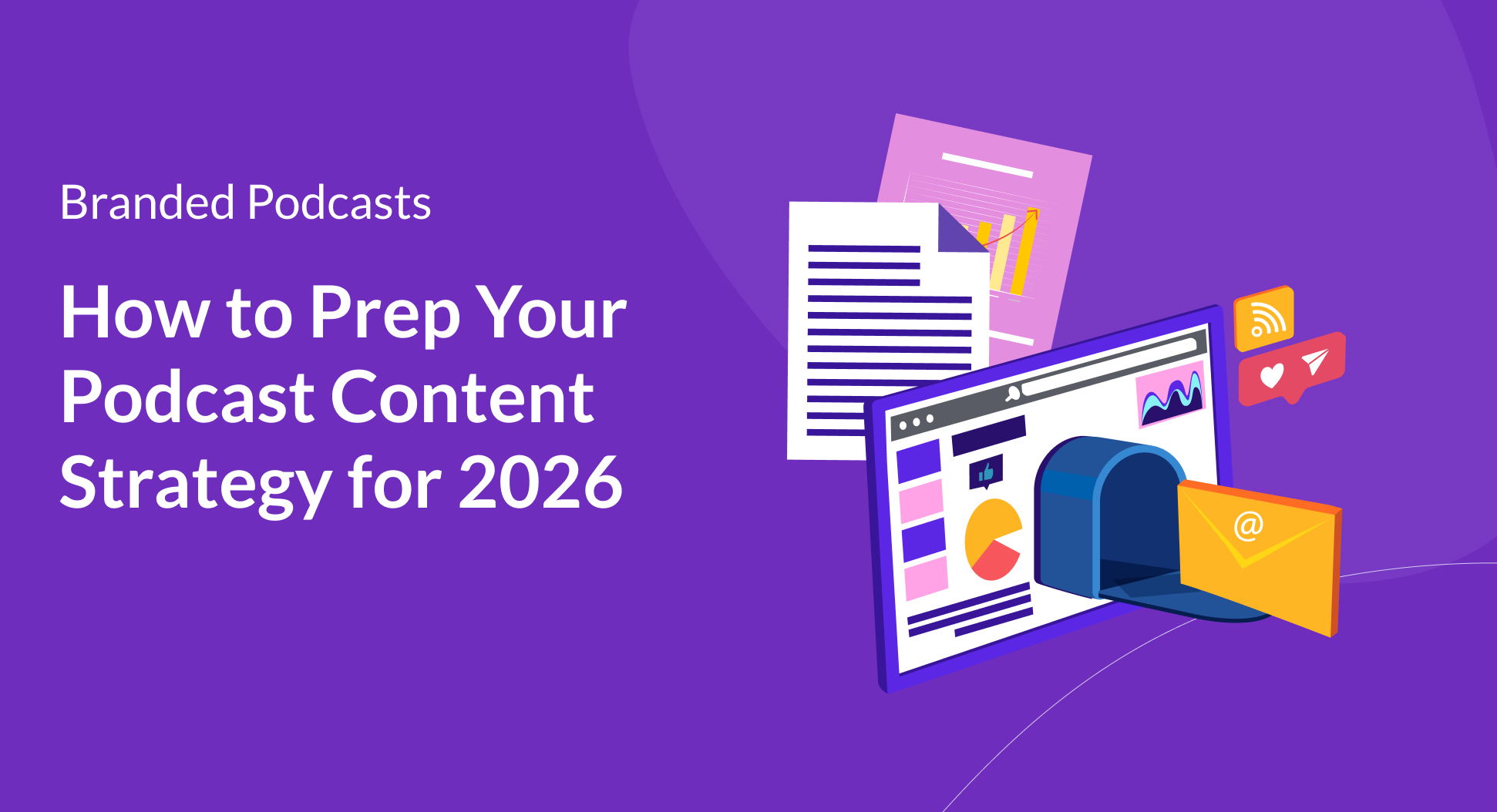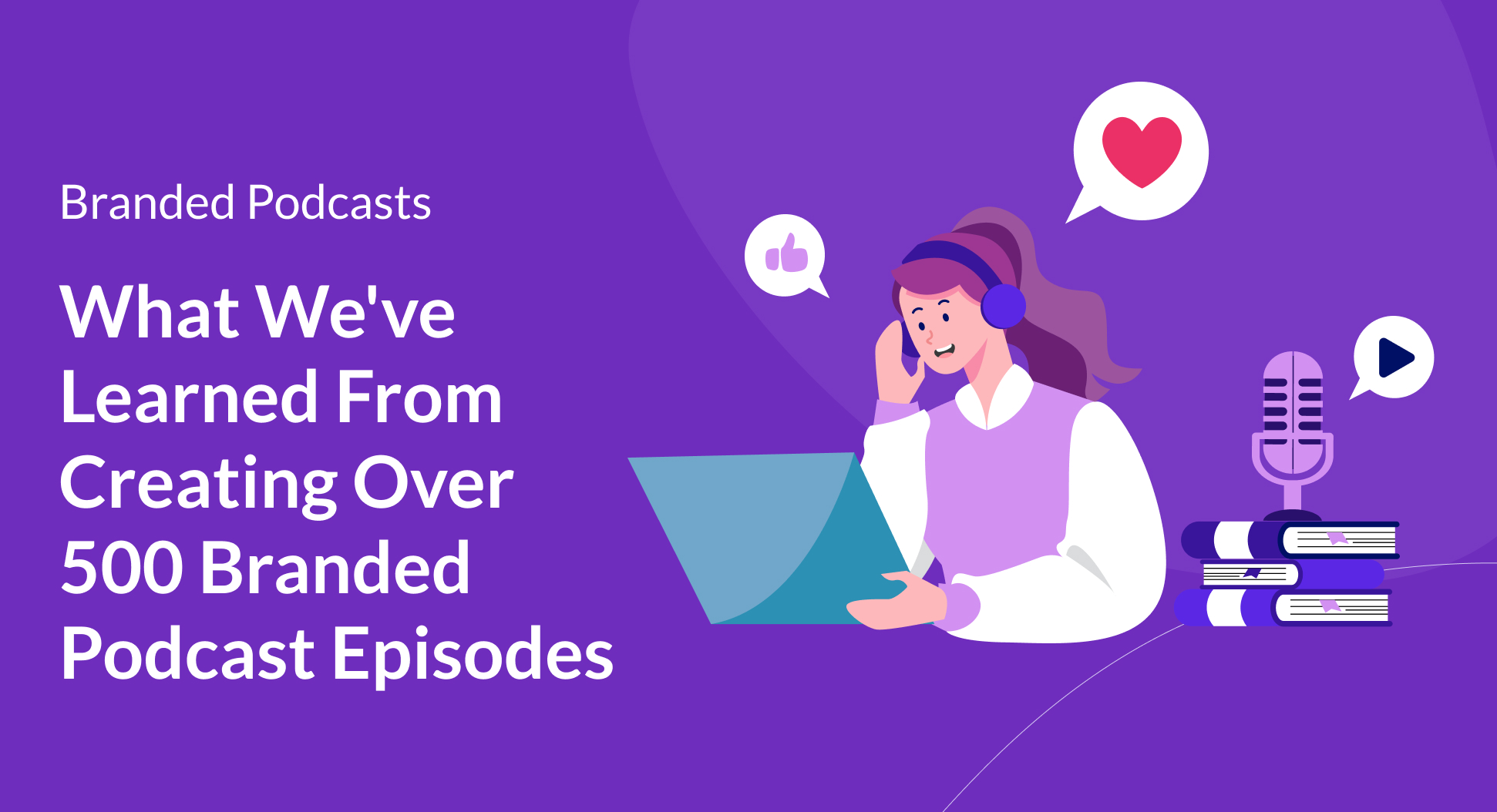Contents
If I were to ask you, what’s the goal of branded podcasts?
You’d likely come up with answers like brand awareness, thought leadership, and maybe even lead generation. And you’re right, those are among some of the most common goals we find branded podcasts have.
But there’s another, less common, goal that our team has spent the past few months mulling over, and how it impacts a brand’s show. What is that goal you ask? Market research.
Branded podcasts can serve as an always-on, high-insights channel for market research.
I know, I know, a bit out of the box, but hear us out. In the article below, we’re diving into how you can use a branded podcast to:
- Test messaging
- Extract audience intelligence
- Feed insights into product, sales, and comms teams
Branded podcasts: The overlooked market research tool
As a marketer, you know the importance of market research.
You need to have a grasp on more general areas like:
- Who your audience is
- Pain points and challenges
- Interests and hobbies
But also understand insights like:
- What content resonates with your audience
- How audiences perceive your brand and solution
- What excites audiences about your brand (and what confuses them)
Traditional market research tactics can not only be expensive, but also provide insights for a certain point in time. On the flip side, branded podcasts as a market research tool are ongoing, organic (aside from the necessary investment to create the show), and feedback-rich.
Benefits of leveraging branded podcasts for research
Most marketing content is a one-way message that you’re pushing out. Think ads, emails, blogs, etc.
But branded podcasts are a unique medium. When done well, they can create a more intimate, longer-form environment that invites active listening rather than just passive hearing.
Typically, listeners are opting in for long stretches, sometimes 30+ minutes, often week after week. That kind of attention creates a unique feedback loop where:
- Listeners share their thoughts (via social, ratings, messages)
- You observe how content performs (episode drop-offs, what’s shared, what’s skipped)
- You hear how guests (customers, partners, etc.) naturally talk about problems, products, or industry trends
Most brands talk at their audience. A podcast lets you talk with them and listen to them, making it a great tool for market research.
What you can learn from your branded podcast
Now, let’s explore some learnings you can actually gather from your branded podcast for market research purposes.
1. Audience sentiment & pain points
Analyze which episodes are resonating with your audience and which are falling flat. This gives you insight into potential audience pain points, challenges, and overall needs in your space.
Example:
A BioTech brand releases two episodes:
- One on marketing legalities
- One on growth strategy for 2026
The growth episode sees a consumption rate of 85%, new listeners, and Spotify comments. The legal episode? 40% consumption and silence.
So what does this mean for the brand’s audience? Growth is a priority. Legal compliance might be less relevant, or already well understood. These insights are incredibly valuable for the BioTech brand to know about their audience.
What to track:
- High vs. low-performing episodes
- Consumption rates and drop-off points
- Direct audience feedback (DMs, reviews, comments)
2. Message testing & language refinement
Your podcast isn’t just a storytelling tool; it’s also a low-pressure space to test messaging.
Try subtly experimenting with:
- Brand taglines
- Product positioning
- Campaign hooks
Important: Keep the episode valuable. Your podcast shouldn’t feel like a press release in disguise. Instead, use the intro and outro to introduce new language or positioning, then observe how it lands.
What to track:
- Inbound inquiries or replies
- A/B test variants (if applicable)
- Traffic spikes to pages or products mentioned
- Listener comments and reviews (Are phrases repeated or called out?)
3. Competitive & industry trends
A key piece of market research is, of course, competitive research.
Understanding the competitive landscape and industry trends is critical for any brand, and your podcast can help with it.
There are two primary ways to go about this:
- Use podcast guests as a lens into what others in the industry are prioritizing
- Observe which topics generate buzz or high consumption rates, especially niche trends. And on the flip side, observe which topics aren’t resonating with your audience.
What to track:
- New listener growth
- Tracking link analytics
- Guest conversations and topics
- High vs. low-performing episodes
- Consumption rates and drop-off points
4. Persona validation
And finally, branded podcasts help you confirm that you’re reaching your ideal customer profile (ICP).
Using demographic and firmographic data (which companies are tuning in, listener job titles, seniority, income brackets, regions, etc.), you can validate whether your content is attracting the right audience. Are you reaching decision-makers? The right industries? Audiences in your target markets?
If not, it may be time to adjust your content strategy, messaging, or guest lineup to better align with who you want to reach.
What to track:
- Company and industry data
- Job titles and seniority levels of listeners
- Location data (are you reaching your primary markets?)
- Any changes or patterns in audience makeup over time
Quill Tip: Use podcast analytics tools like CoHost to gather firmographic, demographic, and psychographic data on your listeners.
Use cases in branded podcasts for market research
Market research isn’t just for marketing departments.
It’s critical knowledge for the entire organization and the different departments that live within it.
Here are some of my favorite use cases for how different teams within a brand can leverage insights from podcasts:
- Marketing: Fine-tune messaging, validate campaign angles, and explore audience segments.
- Product: Capture authentic user needs or recurring feature mentions from guests or feedback.
- Sales: Equip teams with episodes that reflect buyer pain points and can support outreach.
- Comms/PR: Uncover narrative threads or media hooks that can be spun into larger campaigns.
Turn branded podcast insights into action
Collecting podcast insights is one thing, but turning them into action items is a whole other ballgame.
It’s so easy for marketers to gather data and then stop there. We fill out the reports and then let them get lost amongst our files.
So, to ensure your podcast actually becomes a functional market research channel, we need to embed these insights into our planning and operations. Here’s how to do it:
- Build recurring “Podcast Insights” reports: Summarize key audience learnings, episode trends, and listener feedback, then share them internally with the rest of marketing, product, sales, and comms teams.
- Use high-performing episodes as internal conversation starters: What topics are landing? Use them to spark team brainstorms, update messaging frameworks, or reevaluate funnel touchpoints.
- Loop cross-functional teams into season planning: Involve stakeholders from product, brand, or sales early to align episode topics with larger strategic priorities.
- Incorporate podcast data into planning cycles: Feed audience trends and listener feedback into quarterly OKRs, campaign calendars, and persona development exercises.
Start leveraging your branded podcast for market research
If you’re only using your podcast to push content, you’re missing one of the biggest strategic opportunities in audio: learning.
Branded podcasts are uniquely positioned to deliver always-on, authentic, and audience-driven insights that can inform everything from messaging to product direction.
In 2026, the savviest marketers won’t just be asking what content performs best; they’ll ask what content is revealing about their audience. And your podcast might just be the smartest research channel you already have.
To stay up to date on branded podcasts tips, data, and industry happenings, subscribe to our bi-weekly newsletter, The Branded Podcaster.






.png)

.png)




.png)
.png)
.png)
.png)